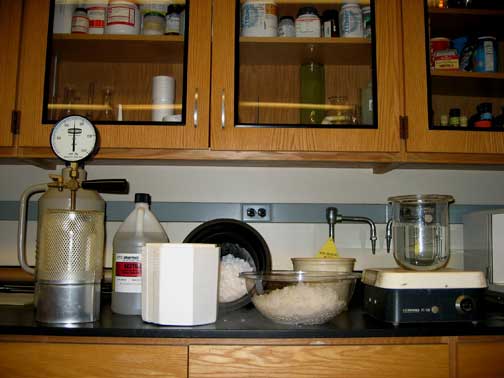 The pressure of a fixed amount of gas confined to a metal bulb is measured at several temperatures. Extrapolation provides a ready estimate the of the "absolute zero" of temperature.
The pressure of a fixed amount of gas confined to a metal bulb is measured at several temperatures. Extrapolation provides a ready estimate the of the "absolute zero" of temperature.
Ingredients: metal bulb attached to pressure gauge, water, hot plate, water ice, dry ice, acetone, liquid nitrogen
Procedure: A complete recipe follows.
1. Place fixed amount of gas in bulb at room temperature.
2. Measure temperature and measure gas pressure.
3. Immerse bulb in boiling water and measure pressure.
4. Repeat measurement of pressure for bulb immersed in freezing water, sublimating dry ice in acetone, and liquid nitrogen.
5. Assuming that the pressure of the confined gas is a linear function of temperature, extrapolate to zero pressure to estimate the "absolute zero" of temperature.
Understanding: For an ideal gas at constant volume and number of molecules of gas, the pressure of the gas will be proportional to the temperature of the gas. We can also say that the pressure divided by the temperature of the gas is a constant. That relation is known as Gay-Lussac's Law, named for the great French scientist Joseph Louis Gay-Lussac (1778-1850). This history is particularly dear to me, as I am a direct descendent of Gay-Lussac. He is buried in Père Lachaise Cemetery in Paris, along with Honoré de Balzac, Frédéric Chopin, Amedeo Modigliani, Jim Morrison, Gertrude Stein, and Oscar Wilde.
We can exploit this law in the following way. We understand pressure to be the force exerted per unit area by a confined gas. If the motion of the gas molecules ceased, we imagine that the pressure would be zero. As the temperature of the gas is reduced, the pressure will be reduced. By Gay-Lussac's Law we expect that the pressure will be proportional to the temperature. As such there must be an temperature at which the pressure is predicted to be zero; below that temperature, the pressure would be predicted to be negative which we take to be unphysical. That temperature at which the pressure is predicted to go to zero is the absolute zero of temperature.
In our experiment we assume that the atmospheric pressure is one atmosphere. The temperatures of our four baths are (1) liquid water at the boiling point, 100C (212F), (2) ice water at the freezing point, 0C (32F), (3) dry ice at the sublimation point in liquid acetone, -78.5C (-109.3F), and (4) liquid nitrogen at the boiling point, -196C (-320F). We found pressures of (1) 975 mmHg, (2) 760 mmHg, (3) 540 mmHg, and (4) 227 mmHg. The measured pressures are a good linear function of the temperature. Extrapolation to the zero of pressure provides an estimate of absolute zero that is comfortably within 10% of the actual value. That is quite remarkable!
Note how we exploit the fact that matter undergoing a phase transition must exist at a well defined temperature and pressure. This eliminates problems that might result from having to measure the temperature of a liquid water bath away from the phase transition, where the temperature might drift if the bath is not well insulated. Exploiting this essential property of a phase transition, that the two phases will coexist only at the temperature of the phase transition, we can know the temperature well without measuring it!
Paying respect to Gay-Lussac
Question:
Use the "visite virtuelle" to explore the Père Lachaise Cemetery and view the grave of Gay-Lussac. Near the grave of Gay-Lussac is the resting place of an individual now associated with a well known pseudo-science. We encountered the pseudo-science earlier in the course, in the context of our discussion of Avogadro's number. Who is that individual?